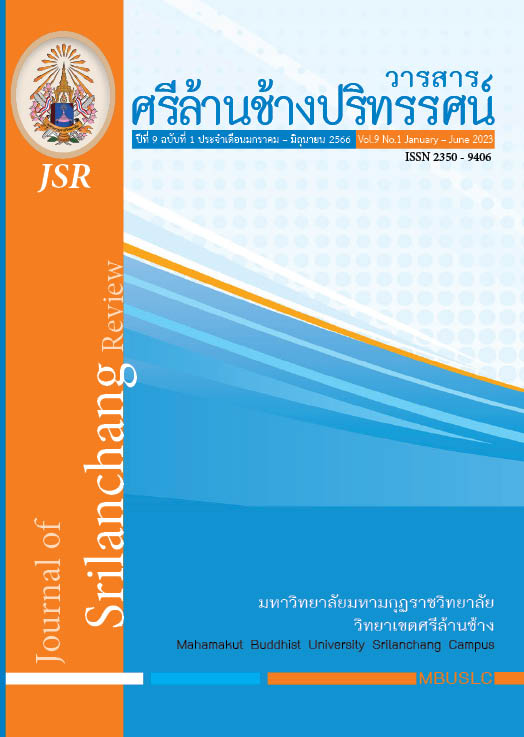THE DEVELOPMENT OF EFFICIENCY AND LISTENING PERCEPTION ABILITIES IN ENGLISH COMMAND SENTENCES IN ENGLISH COMMAND SENTENCES USING TOTAL PHYSICAL RESPONSE (TPR) FOR GRADE 2 ELEMENTARY STUDENTS, NONGBUA WITTAYAYON SCHOOL
Main Article Content
Abstract
The purposes of this research were to: 1) to develop efficiency and listening perception abilities in English command sentences for elementary school (Grade 2 students) between pre-test and post-test learning by using Total Physical Response (TPR) with the criteria 70%, 2) to compare the abilities with the listening perception of English command sentences for Grade 2 elementary students by using Total Physical Response (TPR), and 3) to survey the students' satisfaction with listening perception of English command sentences after learning using Total Physical Response (TPR). The samples used in the study were Grade 2/4 elementary students totaling 40 students of Nongbua Wittayayon School, selected by purposive sampling. The instruments used in the study were: 1) lesson plans, 2) Tests (Pre-test, Post-test), and 3) Satisfaction Survey. The data analysis was analyzed by mean, standard deviation, and t-test for dependent samples.
The results of the study indicated that:
- The development of efficiency and listening perception abilities in English command sentences for Grade 2 elementary students between pre-test and post-test learning by using Total Physical Response (TPR) was significantly increased higher than the criteria 70/70.
- Grade 2 elementary students, Nongbua Wittayayon School were able to listen to the perception of English command sentences by using Total Physical Response (TPR) significantly increased higher than before the experiment at .05 level.
- The students were satisfied with the development of English listening perception in English command sentences for Grade 2 elementary students by using Total Physical Response (TPR) after the experiment was at a highly satisfactory level.
Article Details

This work is licensed under a Creative Commons Attribution-NonCommercial-NoDerivatives 4.0 International License.
บทความที่ได้รับการพิจารณาจากคณะกรรมการผู้ทรงคุณวุฒิและเผยแผ่ในวารสารฉบับนี้ เป็นทัศนคติและข้อคิดเห็นส่วนบุคคลของผู้เขียนแต่ละท่าน ไม่ถือว่าเป็นทัศนะคติและความรับผิดชอบ
ของบรรณาธิการ
บทความ ข้อมูล เนื้อหา รูปภาพ ฯลฯ ที่ได้รับการตีพิมพ์ในวารสารศรีล้านช้างปริทรรศน์ ถือเป็นลิขสิทธิ์ของวารสารศรีล้านช้างปริทรรศน์ หากบุคคลหรือหน่วยงานใดต้องการนำทั้งหมดหรือส่วนหนึ่งส่วนใดไปเผยแพร่ต่อหรือเพื่อกระทำการใด ๆ จะต้องได้รับอนุญาตเป็นลายลักอักษรจากวารสารศรีล้านช้างปริทรรศน์ ก่อนเท่านั้น
References
คำพันธ์ แสนสุข. (2556). การศึกษาการเรียนรู้การฟังและการพูดภาษาอังกฤษของนักเรียนชั้นประถมศึกษาที่ 1 ด้วยวิธีการสอนแบบการตอบสนองด้วยท่าทาง โรงเรียนมัธยมวัดใหม่กรงทองในพระบรมราชูปถัมภ์ สมเด็จพระเทพรัตนราชสุดา สยามบรมราชกุมารี. วิทยานิพนธ์ปริญญาศึกษาศาสตร์มหาบัณฑิต สาขาวิชาการศึกษาระบบสองภาษา บัณฑิตวิทยาลัย มหาวิทยาลัยรังสิต.
ภัทราพร เกษสังข์. (2559). การวิจัยปฏิบัติการ. กรุงเทพฯ: สำนักพิมพ์แห่งจุฬาลงกรณ์มหาวิทยาลัย.
ภัทราพร เกษสังข์. (2549). การวิจัยทางการศึกษา. เลย: ภาควิชาวิจัยและประเมินผลการศึกษา คณะครุศาสตร์ มหาวิทยาลัยราชภัฏเลย.
รมิตา บุญยะมา. (2559). การเปรียบเทียบผลการเรียนรู้และความพึงพอใจในการเรียนภาษาอังกฤษของนักเรียนชั้นประถมศึกษาปีที่ 3 โดยการสอนแบบปกติกับการสอนแบบตอบสนองด้วยท่าทาง (TPR). วารสารออนไลน์บัณฑิตศึกษา คณะศึกษาศาสตร์ มหาวิทยาลัยรามคำแหง.
วารุณี ศิริ และอภิราดี จันทร์แสง. (2560). การพัฒนาการจัดการเรียนรู้โดยใช้วิธีสอนแบบตอบสนองด้วยท่าทาง (TPR) ที่มีผลต่อทักษะการฟังและการพูดภาษาอังกฤษ สำหรับนักเรียนชั้น ประถมศึกษาปีที่ 1. (วิทยานิพนธ์ปริญญาการศึกษามหาบัณฑิต). มหาสารคาม: มหาวิทยาลัยมหาสารคาม.
สำนักงานคณะกรรมการการศึกษาขั้นพื้นฐาน. (2551). หลักสูตรแกนกลางพุทธศักราช 2551. กรุงเทพฯ :คุรุสภาลาดพร้าว.
Asher, J. J. (1968). The Total Physical Response Method for Second Language
Learning. San Jose State College, CA: Department of Psychology.
Ur, P. (1984). Teaching listening comprehension. Cambridge: Cambridge University Press.


